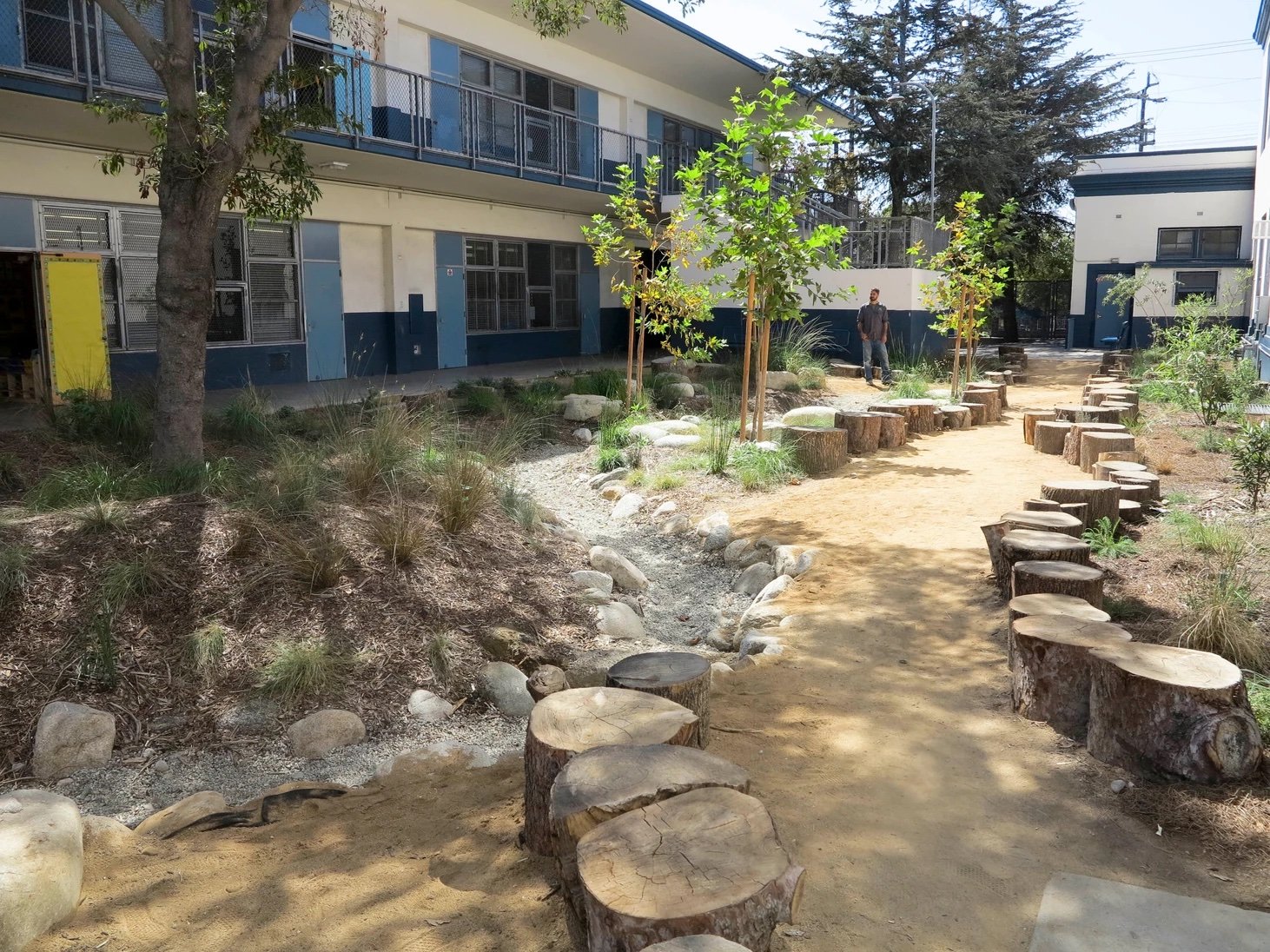
How to Create a Green Schoolyard
A green schoolyard aims to create a beneficial environmental impact through nature-based infrastructure by integrating as many co-benefits as possible such as how trees cannot only provide shade, but capture water, clean the air, and provide habitat and food for small animals and pollinators.
-

DEPAVE
Depaving asphalt and replacing with trees and plants will not only cool down your campus but will create opportunities to use your campus in dynamic ways. READ MORE
-

PLANT TREES
Trees provide multiple benefits for a schoolyard ranging from creating shade, cooling down the air through evapotranspiration, capturing stormwater, to cleaning the air. Most importantly, they help create a general sense of well-being. READ MORE
-

CAPTURE WATER
Los Angeles experiences frequent periods of drought conditions. Greening schoolyards and designing features to capture rainwater can help us keep our waterways cleaner and healthier while recharging groundwater reserves we’ll need in the future. READ MORE
-

PLANT NATIVE PLANTS
Native plants from the Los Angeles area are not only drought tolerant but provide important food and habitat for birds and insects that are rapidly losing resources due to pollution, climate change and overdevelopment. READ MORE
-

OUTDOOR CLASSROOM
Don’t just learn about nature, learn from nature! Green schoolyards can be living laboratories where students can learn first hand about ecosystems, biodiversity and wildlife. Studies have shown that children are calmer and more focused when learning outside and children who struggle from lectures and reading often thrive in hands-on learning experiences and outdoor settings. READ MORE
-

PLAY
Play is the best way for children to develop socially, cognitively, and emotionally. It is where they learn to solve their own problems, experience joy, and learn to get along with their peers. Schoolyards should be designed to maximize play by providing adequate shade, and dynamic spaces that stimulate collaboration and creativity. READ MORE
-

COMPOST
Students generate about 2+ pounds of compostable waste each school day and 60-80% of that waste could be recycled or composted. Food rotting in landfills significantly contributes to methane gas production which traps more heat in the atmosphere per molecule than carbon dioxide (CO2), making it 80 times more harmful. READ MORE
-

SCHOOLS AS PARKS
Having access to your schoolyard on the weekend provides much needed open space to communities around Los Angeles. Read HERE for information how to open your school on the weekend.
How to NOT Green a Campus
To truly mitigate the climate crisis, schoolyard renovations should prioritize materials and processes that benefit humans and the environment long term. Design should benefit nature—not be at the expense of nature. All of the materials on this list exacerbate the climate crisis in their manufacturing and installation process and should not be considered as part of a green schoolyard design.
-

Cool Pavement
Cool pavement refers to a light-colored reflective coating painted on asphalt to lower its temperature. This paint is helpful on roofs and parking lots, but a UCLA study found that it should not be used in areas where there are people. The paint is so reflective that it heats everything around it—including people who can feel up to 7 degrees warmer on “cool pavement”. Additional downsides are that it gets dirty easily, rubs off, or the glare can bother people’s eyes. Often, the paint is more carbon-intensive to produce than the energy it is supposed to save. READ MORE
-

Astroturf aka Plastic Grass
Astroturf aka plastic grass is a petroleum-based product that is carbon-intensive to produce and can measure 30 degrees hotter than asphalt. The infill on top of the turFACT SHEET heref and the turf itself can contain toxic and carcinogenic chemicals that can leach into groundwater. The installation process kills off any soil beneath, making it nearly impossible to switch to grass or plants at a later time. READ MORE and read our FACT SHEET here.
-

Rubber Surfacing
While adults fawn over the bright fun colors of the rubber safety surfacing, this material is very expensive, non-permeable, highly carbon-intensive in both manufacturing and installation, and it gets very hot, raising temperatures on the schoolyard. It also requires a concrete substrate. A more affordable, cooler, and permeable alternative is wood mulch. Plus mulch creates jobs because it requires annual maintenance.
